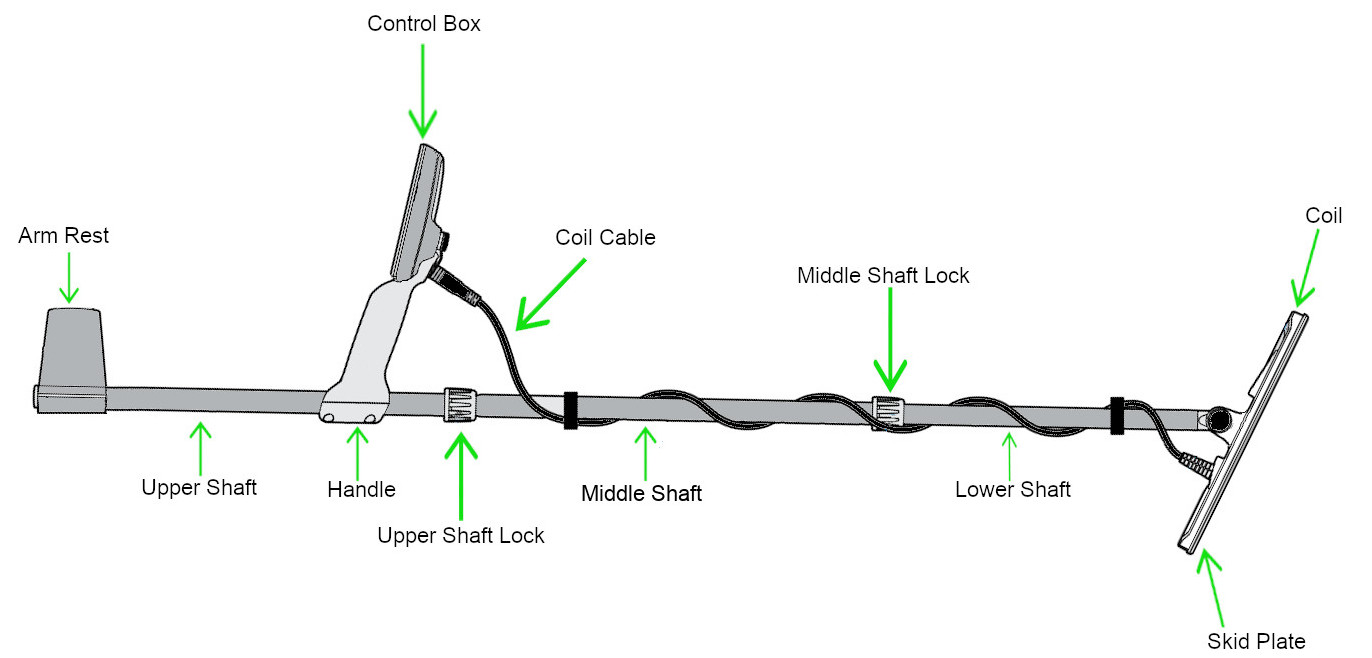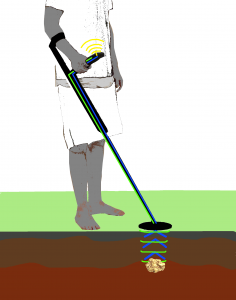
If you have ever wondered how do metal detectors work, then this page is for you. We often forget how amazing metal detectors are and how much they have changed from their original design.
Who invented metal detectors
Spurred on by the thirst for iron ore during the 1800s, scientists and engineers begin to develop devices for locating metal using their expanding knowledge of electrics. These early devices could assist miners locate rocks rich with iron oxides. Early metal detectors were very limited in how well they worked and how long their batteries would last.
A hand held metal detecting device was produced to assist in bullet and shrapnel removal in 1874 by Parisian inventor Gustave Trouvé. Later in 1881 in an attempt to save American President James Garfield’s life after being shot in the chest, Alexander Graham Bell produced a similar device to locate the Bullet. However this device didn’t help to successfully locate the bullet and the President later died from his injuries.
The first metal detector patent was granted to Gerhard Fischer in 1925. He somewhat stumbled upon his metal detector idea whilst producing a way to increase navigation accuracy with radio direction finding.
A business man from the city of Crawfordsville, Indiana named Shirl Herr was the first person to apply for a patent in 1924. Herr’s patent was granted later in 1928. Herr’s metal detector was used to recover items from the bottom of Lake Nemi where Emperor Caligula’s ship laid.
Lieutenant Józef Stanisław Kosacki would go on to refine and produce a design for the mine detector during 1941. He never patented his design and would hand it as a gift to the British Army, greatly assisting the progress of the British Eighth Army. Amazingly this information has been kept secret for over 50 years due to the military’s involvement in its production.
During the 1950s and 1960’s the invention of transistors improved metal detector designs significantly. Transistors meant the circuits could be far smaller in-turn making metal detectors smaller and lighter. Low power circuits have also given the benefit of batteries lasting for longer durations.
In recent times metal detectors are becoming more and more advanced. The best metal detector brands are continuously battling to produce detectors that can find deeper targets, have more accurate discrimination, are less effected by mineralised soils or water and are less susceptible to unwanted noise. Modern day detectors are typically user adjustable for sensitivity and discrimination, some even have user adjustable tones for targets. More expensive metal detectors will often have bluetooth for wireless headphones, be able to connect to Wi-Fi networks or smartphone apps and with some models have the ability to track search zones or found items by using GPS.
Coil designs have also continued to improve over the years. The original coil being a pair of identical coils one placed on top of the other. The double-D and mono loop coil were advancements on the old style and are continued to be used today.
What are the parts of the detector.

There are many different designs of detector some may have the control box built into the LCD display housing, under the armrest, some might even have it in a box that can be worn on the hip.
The coil cable on some detectors can also be slightly different as well, some are coiled around the shaft or wound into a tighter curly cord and concealed within the shaft.
Armrest:
The armrest provides extra weight support for the user. It helps the detector to form part of the users body and promote the use of larger muscle groups. When the detector is swept side to side, the armrest prevents the detector swaying away from the body.
Control Box:
A control box houses the LCD display, control board (electronic circuit board) and coil connector. The control box is what produces the signal and converts received signals to a tone for the user.
Handle:
The handle is where the user holds and controls the detector from. Many metal detectors will have a compartment for the batteries within its handle. Also in some metal detectors it will house a ground balance or volume control button.
Shaft:
The shaft is what holds it all together, most shafts are fully adjustable to suit the user and can be lengthened or shortened using the shaft locks. Typical materials used are aluminium and carbon fibre, both being light weight and strong.
Coil Cable:
The Coil cable connects the control box to the coil. This is the pathway for the transmit and receive signals.
Coil:
The coil is what transmits the signal into the ground and what receives the signal back from a target.
Skid Plate:
Skid plates protect the coil from rough surfaces and can be replaced once warn. It is important to remove the skid plate regularly and remove dirt and debris, as this can lead to false signals if left dirty.
How do metal detectors work

Modern metal detectors are becoming more and more complex, but still work on the same basic principle.
The control box generates and provides a transmit signal to the coil, the coil then transmits an electromagnetic field into the ground (shown in green).
If there is a target in the ground, the transmit signal energises the target which then causes the target to create its own electromagnetic field (shown in blue).
The coil then receives electromagnetic field from the target, where the control box then converts it to a tone to alert the user (shown in yellow).
How deep will a metal detector work
This is a very common question, but difficult to give an exact answer to. There are multiple determining factors such as:
- Detection technology type
- Coil type
- Coil size
- Target positioning, size, shape, composition
- Environmental factors
Detection technology type:
Depending on the target that is being searched for determines the type of technology that should be used.
VLF (Very Low Frequency) is one of the most common types of detector they produce a continuous wave at a single frequency and are a proven method for finding gold.
PI (Pulse induction)
This type of detector generates short voltage pulses at the coil. They can use monoloop and double D type coils and are better than VLF detectors at handling heavily mineralised soil, with the added bonus of having more depth. Pulse induction detectors are very good for finding small traces of gold, discrimination is not as good on these, so be prepared to do a lot of digging.
An interesting note is that some Minelab users have reported Nuggets being found up to depths of 4 ft or 1.2m using their detector with ZVT technology (Zero Voltage Transmission).
Coil type:
Double D
A double D coil can handle noise better than the monoloop, however, they don’t go as deep. They have good sensitivity and depth, and are able to cover more ground.
Monoloop coil
The signal shape from a Monoloop coil is conical in shape, which means they don’t cover as much ground as the double-D. A monoloop will go deeper than the double-D, but can be tricky to ground balance in heavily mineralised ground.
Coil size:
Typically bigger is better, the coil will cover more area and also will search deeper. Trade offs are losing the ability to find small specimen gold and being more easily effected by interference.
The opposite is true for smaller coils, better at finding small targets at shallow depths and are less likely to get interference.
When searching for coin or treasure a large coil for search larger areas faster might be a good option or a smaller coil for targets that aren’t as deep close by to junk.
Target positioning, size, shape:
A nice large coin laying flat and close to the surface will be easier than finding a small coin laying upright and well below the surface. The same is true about a large or small piece of gold.
Environmental factors:
When operating a detector, keeping in mind environmental noise sources is important.
Things to keep away from:
- Mobile phone towers
- Antenna towers
- Overhead power lines and cables
- Underground power lines
- Other metal detectors
Weather conditions such as thunderstorms can also have an effect on metal detectors.
Metal detector uses
Metal detectors aren’t just for recreational users, detectors are used in vast and varying fields, some are in industries you might not have thought of before.
Recreation:
The most well known fields would be for recreation or hobby searching for gold, coin, treasure and relics. Some people in the metal detector world have their own terms for more specialized categories of recreational detecting.
Those that choose to detect on beaches, often targeting lost jewellery, coins or other metallic objects are called beachcombers because they are effectively “combing” the beach.
Searching for gold, silver or copper is typically known as prospecting.
When searching exclusively for gold and silver coins, it is sometimes known as “coin shooting”.
General metal detecting as a term covers most relic hunting. This will normally involve searching for and preserving ancient artefacts.
Archaeology finding artefacts:
Some archaeologists will use metal detectors during their site digs, when significant finds are made, archeologists ensure that the full context of the find is recorded and the item preserved correctly.
Military and humanitarian:
The military use metal detectors to clear a safe path for vehicles and soldiers, this is done on the battlefield and is only done when required. They typically don’t clear the mines for the surrounding civilians.
Humanitarian efforts aim to clear mines for the benefit of all. This helps civilians to re visit areas that would be otherwise be unsafe without mine clearing and return to their everyday lives.
Security:
With the increased threat of terrorism, security has been stepped up in public places especially in airports and sporting events. Handheld devices are seen more frequently, being waved across the body checking for metallic items such as knives or firearms. The more familiar walkthrough style detector are a staple in most security check points with improvements on discrimination over the years.
Industrial:
Metal detectors are common place in food processing facilities, assuring that any metal contaminates are found before winding up at the consumer. Metal detectors are not only found in food processing, they have been introduced into beverage, clothing and even pharmaceutical processing/packaging facilities.








